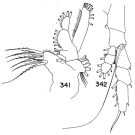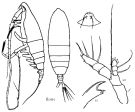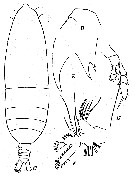|
|
 |
|
Calanoida ( Order ) |
|
|
|
Arietelloidea ( Superfamily ) |
|
|
|
Augaptilidae ( Family ) |
|
|
|
Haloptilus ( Genus ) |
|
|
| |
Haloptilus longicirrus Brodsky, 1950 (F) | |
| | | | | | | Syn.: | Haloptilus setuliger Tanaka, 1964 b (p.40, Descr.F, figs.F); Itoh, 1970 a (p.5: tab.1); Matthews, 1972 (p.50-51, Rem., 54); Harding, 1974 (p.141, tab.2); Park, 1988 (p.21, Rem.); Shih & Young,1995 (p.68); Lo & al., 2004 (p.89, tab.1);
no Haloptilus longicirrus : Bradford, 1970 a (p.359, figs.F) | | | | Ref.: | | | Brodsky, 1950 (1967) (p.363, Descr.F, figs.F); Grice, 1963 a (p.498, figs.F); Vervoort, 1965 (p.124, Rem.); Park, 1970 (p.535, figs.F, Rem.); Minoda, 1971 (p.40); Matthews, 1972 (p.50); Park, 1988 (p.21, Descr.F, figs.F, Rem.); Razouls, 1994 (p.195, figs.F); Bradford-Grieve & al., 1999 (p.883, 941, figs.F); Vives & Shmeleva, 2007 (p.256, figs.F, Rem.) |  Comparison between H. longicirrus and H. paralongicirrus issued from : T. Park, 1970, 1988. Haloptilus longicirrus Female: 1, habitus (dorsal view); 2 & 2', Head (dorsal, ventral, respectively); 3, 3', 3'', Urosome (dorsal, ventral, lateral, respectively) . Haloptilus paralongicirrus Female: 4, dorsal view; 5 & 5', Head (dorsal, ventral, respectively); 6 & 6', Urosome (dorsal, ventral, respectively); 7 & 7', genital segment (lateral, ventral, respectively).
|
 issued from : T. Park in Antarct. Res. Ser. Washington, 1988, 47. [p.22, Fig.13]. Female : a, forehead (dorsal); b, urosome (ventral). Nota: Riostral filaments well developed.
|
 Issued from : T. S. Park in Bull. Mar. Sc., 1970, 20 (2). [p.534, Figs.330-340]. Female (from Caribbean Sea & G. of Mexico): 330, habitus (dorsal); 331, idem (lateral right side); 332, forehead (dorsal); 333, idem (ventral); 334, idem (lateral); 335, urosome (dorsal); 336, idem (lateral right side); 337, genital segment (ventral): 338, A2; 339, Md; 340, Md (biting edge). Nota: Forehead with a round projection, which in dorsal view is not set off as it is in H. longicornis. Genital segment about as wide as long, and two spermathecae widely separated. Caudal rami more than twice as long as wide.
|
 Issued from : T. S. Park in Bull. Mar. Sc., 1970, 20 (2). [p.536, Figs.341-342]. Female: 341, Mx1; 342, P5 (anterior). Nota: Exopod of A2 7-segmented. Basis of Mx1 with 5 setae. P5: coxa and 2nd exopodal segment each with a small internal seta; basis with an external seta which is about twice as long as exopod.
|
 Issued from : K.A. Brodskii in Calanoida of the Far Eastern Seas and Polar Basin of the USSR. Opred. Fauna SSSR, 1950, 35 (Israel Program for Scientific Translations, Jerusalem, 1967) [p.363, Fig.254]. Female (from NW Pacific): habitus (dorsal and lateral left side); forehead (ventral); M, Md (biting edge); S5, P5 (probably the inner seta on basipodal segment 1 is lacking in the figure).
|
 issued from : G.D. Grice Bull. mar. Sc. Gulf Caribb., 1963, 13 (4). [p.499, Fig.C-G].
Female (from NW toppical Atlantic): C, habitus (dorsal); D, forehead (lateral); E, Md (biting edge); F, Mx1; G, P5.
|
 Issued from : C. Razouls in Ann. Inst. océanogr., Paris, 1994, 70 (1). [p.195]. Caractéristiques morphologiques de Haloptilus longicirrus femelles adultes. Terminologie et abbréviations: voir à Calanus propinquus.
| | | | | Compl. Ref.: | | | Park, 1970 (p.478); Roe, 1972 (p.277, tabl.1, tabl.2); 1972 c (p.1034); Deevey & Brooks, 1977 (p.156, tab.2, Station "S"); Buchanan & Sekerak, 1982 (p.41, vertical distribution); Vives, 1982 (p.293); Lozano Soldevilla & al., 1988 (p.60); Errhif & al., 1997 (p.422); Razouls & al., 2000 (p.343, Appendix); Yamaguchi & al., 2002 (p.1007, tab.1); Galbraith, 2009 (pers. comm.); Park & Ferrari, 2009 (p.143, Table 4, Appendix 1, biogeography); Homma & Yamaguchi, 2010 (p.965, Table 2); Medellin-Mora & Navas S., 2010 (p.265, Tab. 2); Hsiao S.H. & al., 2011 (p.475, Appendix I); Homma & al., 2011 (p.29, Table 2, abundance); Bonecker & a., 2014 (p.445, Table II: frequency, horizontal & vertical distributions, Table IV: new geographical record) | | | | NZ: | 10 + 1 doubtful | | |
|
Distribution map of Haloptilus longicirrus by geographical zones
|
| | | | | | | | | | | |  Chart of 1996 Chart of 1996 | |
| | | | Loc: | | | Antarct. (SE Pacif.), Indian (S subtropical convergence), SW Atlant., Brazil (off Rio de Janeiro), G. of Guinea, Canary Is., Caribbean Colombia, Caribbean Sea, Caribbean Colombia, G. of Mexico, off Bermuda (Station "S"), Sargasso Sea, off SE Cape Cod, NW Pacif., Station Knot, Bering Sea, S Aleutian Basin, S China Sea, Vancouver Is., Taiwan (Kuroshio Current); ? Arctic (W Baffin Bay in Buchanan & Sekerak, 1982 (p.41, Table 2) | | | | N: | 22 | | | | Lg.: | | | (16) F: 3,1-2,84; (22) F: 3,4; (69) F: 3,27; (87) F: 3,2-2,9; (88) F: 3,32-2,96; (199) F: 3,04-2,89; (208) F: 3,77; (313) F: 2; {F: 2,00-3,77} | | | | Rem.: | bathy-abyssopelagic. Known at depths from around 600 to below 1000 m (Matthews, 1972). Sampling depth (Antarct.): 0-600 m. Sargasso Sea: 500-2000 m (Deevey & Brooks, 1977, Station "S");
Vervoort points out the resemblance with H. longicornis: The specimens from the Gulf of Guinea resemble in many aspects, particularly the great length of A1, but differ 1- they are much larger; 2- the frontal part of the head has only a very slight and rounded protusion, bearing the rostral filaments. These filaments at their base are distinctly swollen; 3- the setiform spine at the outer margin of the coxa of P5 in the female is greatly lengthened; it is about twice as long as the exopodite. In the Atlantide Expedition the specimens agree perfectly with Brodsky's H. longicirrus.. For Brodsky (1967, p.364) this species resembles E. longicornis but differs in size, in the greater length of the caudal rami, and in the structure of P5.
Park (1970, p.537) believes H. setuliger Tanaka (1964) synonymous of this species.
For Itoh (1970 a, fig.2, from co-ordonates) the Itoh's index value from mandibular gnathobase = 2320 (as H. setuliger).
See remaks in H. paralongicirrus Park, 1970.
Mx1 after Bradford-Grieve (1999, p.941) : Exopodite of Mx1 female with 9 setae. Outer seta of P5 basipodite more than twice length of the exopodite. | | | Last update : 29/01/2017 | |
|
|
 Any use of this site for a publication will be mentioned with the following reference : Any use of this site for a publication will be mentioned with the following reference :
Razouls C., Desreumaux N., Kouwenberg J. and de Bovée F., 2005-2025. - Biodiversity of Marine Planktonic Copepods (morphology, geographical distribution and biological data). Sorbonne University, CNRS. Available at http://copepodes.obs-banyuls.fr/en [Accessed December 24, 2025] © copyright 2005-2025 Sorbonne University, CNRS
|
|
 |
 |









